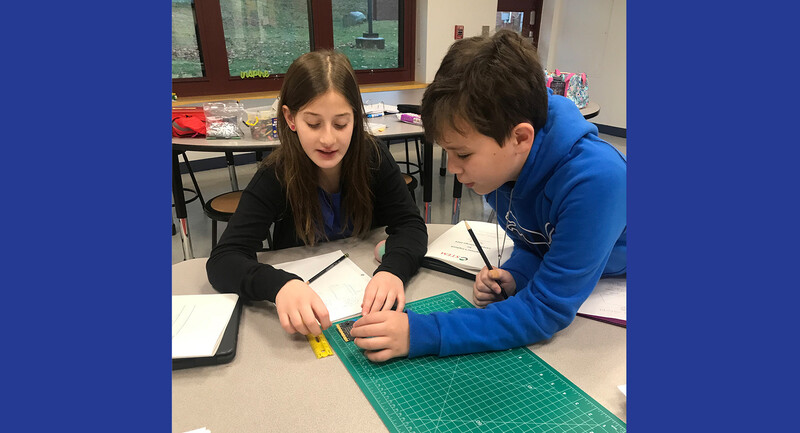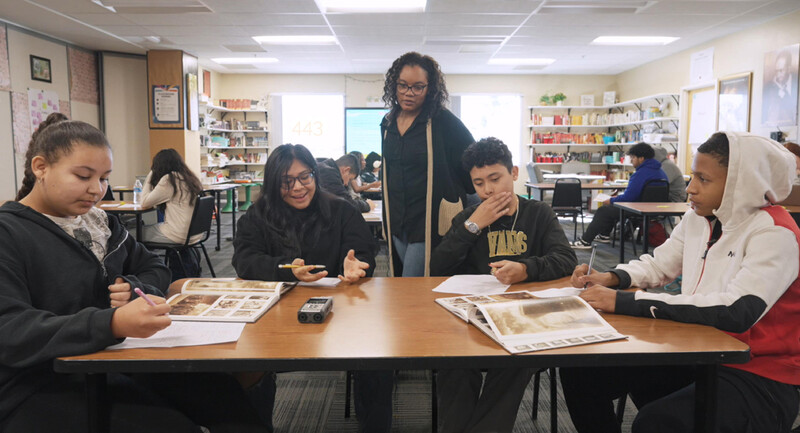More than five years ago, I visited the Key School in Indianapolis, one of the first schools to implement the theory of multiple intelligences. After seeing the work teachers were doing there, I decided that multiple intelligences could be a useful tool for our school, the New City School in St. Louis, Missouri.
The Talent Committee, made up of approximately one-third of the faculty, began meeting to read and discuss Howard Gardner's Frames of Mind (1983). Teams of teachers took responsibility for presenting chapters to the rest of the committee using the intelligences described in each chapter to get their ideas across. For example, we engaged in various physical exercises to study the bodily-kinesthetic intelligence; used graphics and visual puzzles to understand spatial intelligence; songs and rhythms to learn about musical intelligence; and so on.
Our group spent the remainder of the year discussing how we could use multiple intelligences in our school and creating a list of the things we were already doing that fit with the theory. We then generated a list of steps that we should take, including those that we could do fairly easily and those that would require major changes or extra funding.
To ensure that all of the faculty understood and showed enthusiasm for multiple intelligences, the Talent Committee kept nonmembers informed. At faculty meetings, teachers talked about what they were doing in their classrooms, sharing what worked and what didn't. Over time, more than half of the faculty participated in the Talent Committee's work. Teachers began to experiment with multiple intelligences; each year more and more teachers began using it in their classrooms; and today the concept is found in all of our classrooms, with various approaches and to varying degrees. At the same time, I shared our work in my weekly letters to parents, at parent meetings, and in my monthly reports to the board of directors. We knew it was important that all of the stakeholders understand our approach to multiple intelligences.
We have found that multiple intelligences is more than a theory of intelligence; it is, for us, a philosophy about education with implications for how kids learn, how teachers should teach, and how schools should operate. At first, the pursuit of multiple intelligences served as a focus for our professional development. Then, as we began to bring multiple intelligences into the classroom, we found that we had not only modified our curriculum, but we had also begun to assess students differently. Finally, from there we realized that we had to change both what and how we communicated with parents.
Planning Professional Development
Implementing multiple intelligences has had a profound effect on our teachers' professional development. The Talent Committee has continued to meet, discussing other related books such as Flow (Csikszentmihalyi 1990) and The Unschooled Mind (Gardner 1991). It has also studied student assessment, higher-level thinking skills, teaching for understanding, and parent communications. At faculty meetings, the committee often invites teachers to share how they approach a particular intelligence, facilitates discussion of how to use all of the intelligences in the classroom, or helps plan faculty meetings and inservices.
In order to pursue the many different directions that we have taken as a result of our work, we formed new faculty committees. The Parent Communication Committee is revising the progress report to address multiple intelligences and teaching for understanding. Other committees are addressing the use of portfolios, planning a multiple intelligences conference, and creating a book to help other teachers use multiple intelligences in their classrooms.
Enhancing the Curriculum
Multiple intelligences theory says that there are seven different intelligences: linguistic, logical-mathematical, spatial, bodily-kinesthetic, musical, intrapersonal, and interpersonal. Schools are typically organized around the linguistic and logical-mathematical intelligences. If a child is strong in these intelligences, success comes easily, but not all children are strong in these areas. We decided that we needed to design our curriculum so that all children could learn and succeed through their strengths in the particular intelligences.
This does not mean that every lesson must have seven different options or that all seven intelligences must be represented equally throughout the curriculum. It does mean, however, that teachers need to consider all of the intelligences in planning instruction and assessment. Because children learn best when they use their strengths, they need opportunities to use all of the intelligences throughout the day.
For example, teachers can help a child whose strength is bodily-kinesthetic use that talent to learn multiplication facts or spelling words; capitalize on children's interpersonal intelligences by using the study of personalities as a pathway to the study of history; or use graphs and tables to record the similarities and differences among Native American tribes to help students with strong logical-mathematical intelligence. Using multiple intelligences helps teachers look for new ways to relate curriculum to their students.
Improving Assessment
Portfolios. Portfolios quickly emerged as a way to capture all of a student's multiple intelligences. The Portfolio Committee looked at how portfolios should be organized, deciding that all of the multiple intelligences would be represented at least once each year in a student's portfolio, even those in which the student is not strong. The committee created a system for recording what was kept in the portfolios and the rationale for inclusion of items, and planned Portfolio Nights at which teachers and students would share portfolios with parents. Some teachers began experimenting with Teacher Portfolios, compiling collections of work and reflections of their professional growth to share with the administration.
Progress reports. Because what you measure reflects what you value, we decided to devote the entire first page of our Progress Report to intrapersonal and interpersonal intelligences. Teachers use checklists and narrative comments to report such attributes as confidence, teamwork, appreciation for diversity, and motivation. Because these intelligences are more subjective than the more traditional ones, the faculty created a booklet for teachers that contains teaching and assessment strategies for the personal intelligences.
Profiles. To ensure that teachers used all of the intelligences in all classrooms, the Parent Communications Committee developed a Multiple Intelligences Profile (see fig. 1). The profile is sent home each spring. When used in conjunction with the reports from the specialist teachers, these profiles give the parents a rich picture of their child's intelligence. Using the profile in the classroom also increases the likelihood that teachers will recognize and address all of the students' intelligences.
Genuine understanding. At first, our work dealt primarily with using multiple intelligences to acquire skills. Later, eliciting genuine understanding—using skills and knowledge in novel situations—became a focus. The Parent Communications Committee is incorporating genuine understanding in our Progress Report. We want students to be “able to do a variety of thought-demanding things with a topic—like explaining, finding evidence and examples, generalizing, applying, analogizing, and representing the topic in a new way” (Perkins and Blythe 1994).Thus far, what we have found is that genuine understanding is quite different in the younger grades than it is with older students. A teacher of 3-year-old students remarked, “Genuine understanding at my level is the children learning not to hit one another and to use the restroom!” While that is an easy, albeit valid, distinction, determining what genuine understanding is for 1st, 3rd, and 6th graders is proving to be a complex task.
Standardized tests. Despite their limitations, standardized tests remain society's educational gatekeepers; so it is important that our students learn to do well on them. These tests, along with traditional measures of achievement—essays, homework, portfolios, and projects, exhibitions, and performances—offer a rich, comprehensive picture of a student's progress.
Figure 1. Multiple Intelligences Profile
[figure currently unavailable]
Communicating with Parents
Although we changed the format of the Progress Reports to address multiple intelligences and added the Multiple Intelligences Profile, we realized that we needed to do a better job of getting information from parents about their children. What lessons does she take? How does he play? What are her hobbies? How does he spend free time? Questions like these are all critical to understanding a child's multiple intelligences. We realized that neither the typical 30-minute parent/teacher conferences (held three times per year) nor the numerous phone calls and parent meetings enabled us to extract this information.
Following the suggestion of our preschool teachers, we changed our first parent/teacher conference into an Intake Conference. Held the first week in October, this conference allowed teachers to hear from parents, not talk to them. Our plan, explained in both parent letters and faculty bulletins, was for parents to talk 80 percent of the time. Because this was new to everyone, we sent home notes with sample questions to help parents prepare for the conference. The reactions from both parents and teachers were positive. One teacher said, “It was great. I knew my kids as well in November as I normally do in May!” Parents were also pleased to begin the year expressing their perspectives about their children.
Nothing Is Easy
Implementing multiple intelligences has not taken place without difficulties. It is not easy to find ways to incorporate all of the intelligences into curriculum design and planning. In particular, our staff has found utilizing the musical intelligence to be the most difficult route to integrating multiple intelligences, probably because most teachers feel least proficient in this area. But even when staff members feel comfortable with all of the intelligences, teachers need additional time for planning and preparation.
We have found it more difficult to incorporate multiple intelligences into 5th and 6th grade curriculums than in the preschool or primary grades. As expectations for subject matter mastery and preparations for the transition to secondary school become more delineated and rigorous, it is often harder to incorporate intelligences other than linguistic and logical-mathematical into the curriculum. This is an issue that we continue to explore.
Helping newly hired faculty members adjust requires both time and energy. While being new at any school can be difficult, our work with multiple intelligences has exacerbated the learning curve for our new teachers. We use both mentors and New Teacher Orientations, held throughout the year, to help our newer teachers understand multiple intelligences and our work with it.
Pursuing multiple intelligences on a schoolwide basis requires an enormous amount of time and energy. We have six days of professional development in August, including an overnight retreat; several inservice days throughout the school year; and numerous faculty meetings. But that is not enough. Teachers need more time to experiment, refine, and share.
The more we know, the more we realize what we don't know. I liken our pursuit of multiple intelligences to climbing a mountain and finally reaching the summit, only to realize that it is only a ridge and another summit is ahead. And, of course, that summit, too, turns out to be another ridge with another summit in the distance.
Despite these difficulties, we have found multiple intelligences to be a powerful tool for helping kids. As our work with multiple intelligences has pervaded all aspects of the school, the sense of collegiality among our faculty has risen dramatically. The distinctions among curriculum, instruction, evaluation, and parent communication have blurred, reflecting the fact that they are integrally associated with one another. Our work with multiple intelligences has empowered teachers to begin their planning by looking at kids' strengths. Most important, it has helped more of our kids succeed.







